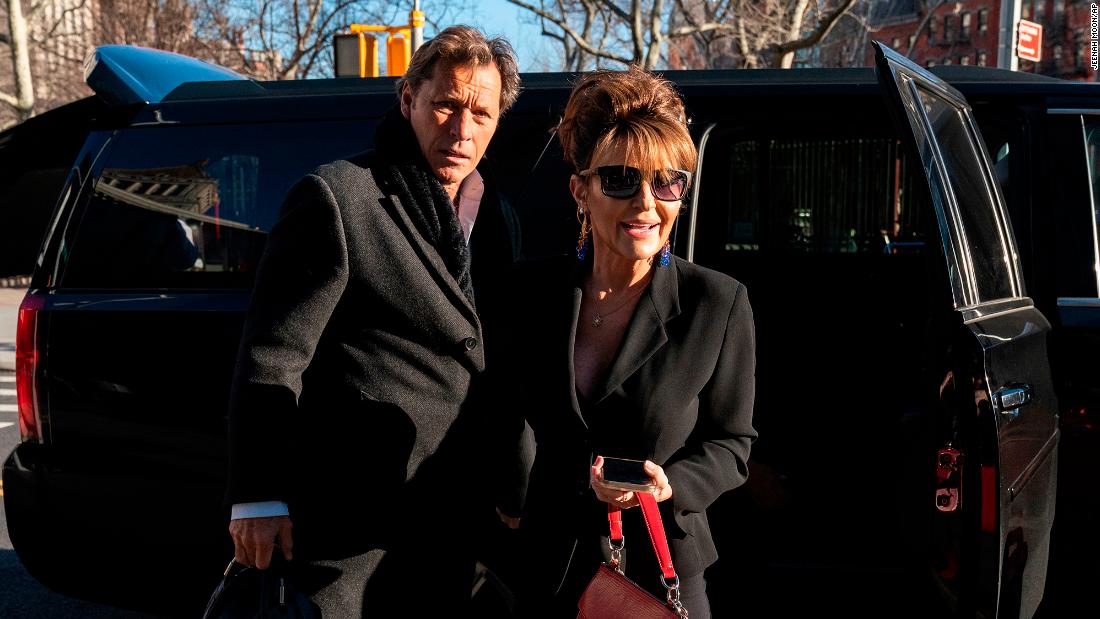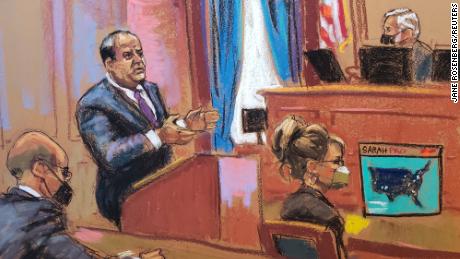A jury of nine New Yorkers, made up of five women and four men, deliberated for about two hours starting Friday afternoon. They are expected to resume deliberations Monday at 9:30 a.m.
The trial began February 3 in Manhattan federal court. Palin has been in attendance daily, and took the stand to testify on Wednesday and Thursday.
Kenneth Turkel, an attorney for Palin, told jurors they should recognize that this was more than a small error and to recognize that the Times and Bennet “crossed that line.”
“In 2017, when the Times resurrected a horrific false accusation that had been recognized as false almost uniformly and that, in its simplest form, accused Governor Palin of inciting a murder of six people, a federal judge, a 9-year-old girl, at a time when she had a 9-year-old girl,” Turkel said. “It became time to draw a line.”
David Axelrod, an attorney for The New York Times, told jurors that this case could have far-reaching implications and potentially have a “chilling effect” on newspapers like the Times.
“They might be forced to significantly reduce the content. They might be forced to not wade into thorny issues of public concern. They might be forced to not take on the powerful in this country. That’s why this needs protection,” Axelrod said. “This case is more than just about Sarah Palin. It’s also about the Times and why we need media. And the values of the First Amendment.”
Palin alleged the piece caused her reputational harm and asked the jury to find the newspaper liable for libel, and to determine an amount that she should be awarded for damages.
What the jurors have heard
The civil trial took place over seven days and the nine jurors saw drafts of the editorial, heard testimony from New York Times journalists who played a role in the writing and editing of the piece, and saw messages between the journalists in the hours before and after the piece was published.
“I was powerless. I didn’t have the political action committee up and running. I didn’t have any television contracts. I didn’t have that platform,” Palin testified on Thursday.
Bennet also took the stand, testifying that he was at first surprised that some people interpreted the editorial as saying the man who shot Giffords and others was incited by Palin, testifying “that is not the message we intended to send.”
Bennet’s face turned red and he shook his head as an attorney read the erroneous line Bennet added into the piece.
“I have regretted this pretty much every day since,” Bennet said.
While Palin’s attorneys have asserted that Bennet “had a political narrative” and that the piece was a “political hit job,” emails shown in court details discussions between multiple editorial board members who mulled over the idea for the editorial in the hours after Scalise was shot. Multiple current and former New York Times journalists also testified about their role working on the piece, including fact checking, and Axelrod told jurors Friday, “there were a lot of eyes that were put on this editorial.”
‘The libel trial of the century’
If Palin loses her case in district court, she can try to appeal her case all the way up to the Supreme Court, which could decide to overturn the previous precedent-setting case, New York Times v. Sullivan. That case set the standard that a public figure must prove that an outlet operated with actual malice when it published a defamatory statement. Actual malice, explains David Logan, a law professor specializing in First Amendment protections, is difficult to prove.
“You’ve basically got to show somebody set out to lie, took every step along the way to refuse to acknowledge the truth and then published and walked away from it,” Logan said.
With Palin’s case, Logan said, the dynamics are fascinating: a local jury evaluating the work of its local paper in a case instigated by a controversial public figure.
“It’s the libel trial of the century. I don’t say that lightly,” Logan told CNN.
“I don’t think the Court will do that because the Times decision is such a cornerstone of First Amendment jurisprudence and it has been endorsed over and over again by Justices across the political spectrum for many years, even though two Justices recently urged that it be revisited,” Boutrous said.
Logan, however, believes it’s time for the Supreme Court to revisit the decades-old standards set by New York Times v. Sullivan, in part, because of the 24/7 nature of information being publicly shared by media. He believes the standard of actual malice, as it’s being interpreted now, is too difficult to prove, and allows false information to be published without consequences.
“My position is that we would be better off if the standard wasn’t as high and more of these cases could go to juries because I think it would have a significant positive deterrent effect on the frequency with which this information is pumped out into our media ecosystem,” Logan said.





More News
Comet Fragment Explodes in Dark Skies Over Spain and Portugal
Global Tensions and a Hostile Neighbor Await Taiwan’s New Leader
Biden Draws on Themes of Manhood and Faith at Morehouse Commencement